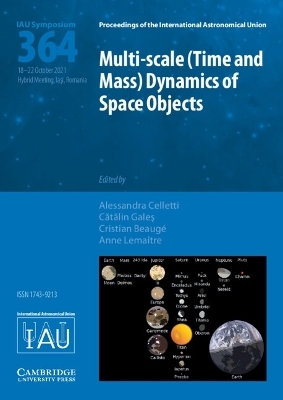
Multi-scale (Time and Mass) Dynamics of Space Objects (IAU S364)
Cambridge University Press (Verlag)
978-1-108-49076-4 (ISBN)
The range of phenomena that manifest at all different time and length scales and the wide range of sizes of space objects, from minor bodies in the Solar System to exoplanets, and from dust particles to Jupiter-size bodies, require the development of dynamical modeling and analysis tools that can handle these different scales. This volume collects contributions given by distinguished scientists at the hybrid IAU Symposium 364. The methods in dynamics modeling of space objects have already reached a state of maturity, and their implementation provided a large number of important results pertaining to both the theory and their applications. The contributions cover the recent advances in the multi-scale dynamics of natural and artificial space objects from various perspectives, which will benefit graduate students and researchers working in the fields of celestial mechanics, astrodynamics, planetary sciences, applied mathematics and dynamical systems.
1. Dynamical constraints on the evolution of the inner asteroid belt and the sources of meteorites; 2. On tides and exoplanets; 3. Evolution of INPOP planetary ephemerides and Bepi-Colombo simulations; 4. The Lidov-Kozai resonance at different scales; 5. A numerical criterion evaluating the robustness of planetary architectures; 6. New results on orbital resonances; 7. Latitudinal variations of charged dust in co-orbital resonance with Jupiter; 8. Chaos identification through the auto-correlation function indicator (ACFI); 9. Closed-form perturbation theory in the Sun-Jupiter restricted three body problem without relegation; 10. The current orbit of Atlas (S XV); 11. Evolution and stability of Laplace-like resonances under tidal dissipation; 12. Back-tracing space debris using proper elements; 13. Four- and five-body periodic Caledonian orbits; 14. Satellites' orbital stability through normal forms; 15. Noise, friction and the radial-orbit instability in anisotropic stellar systems: stochastic N-body simulations; 16. A cartographic study of spin-orbit coupling in binary asteroids; 17. Probabilistic evolution of pairs of trans-Neptunian objects in close orbits; 18. Multiple bifurcations around 433 Eros with Harmonic Balance Method; 19. The effect of the passage of Gliese 710 on Oort cloud comets; 20. Weak stability transition region near the orbit of the Moon; 21. Secular dynamics in extrasolar systems with two planets in mutually inclined orbits; 22. Dynamics around the binary system (65803) Didymos; 23. Orbit propagation around small bodies using spherical harmonic coefficients obtained from polyhedron shape models; 24. The semi-analytical motion theory of the third order in planetary masses for the Sun-Jupiter-Saturn-Uranus-Neptune's system; 25. On the scattering and dynamical evolution of Oort cloud comets caused by a stellar fly-by; 26. Planetary and lunar ephemeris EPM2021 and its significance for solar system research; 27. Some of the most interesting cases of close asteroid pairs perturbed by resonance; 28. Characterization of the stability for trajectories exterior to Jupiter in the restricted three-body problem via closed-form perturbation theory; 29. Astrometry and photometry of asteroids from the UkrVO database of astroplates; 30. Families of periodic orbits around asteroids: from shape symmetry to asymmetry; 31. Oscillations around tidal pseudo-synchronous solutions for circumbinary planets; 32. Apsidal alignment in migrating dust: crescent features caused by eccentric planets; 33. Cascade disruption in Rampo family; 34. An algorithm for automatic identification of asymmetric transits in the TESS database.
| Erscheinungsdatum | 29.07.2022 |
|---|---|
| Reihe/Serie | Proceedings of the International Astronomical Union Symposia and Colloquia |
| Zusatzinfo | Worked examples or Exercises |
| Verlagsort | Cambridge |
| Sprache | englisch |
| Maße | 180 x 252 mm |
| Gewicht | 620 g |
| Themenwelt | Naturwissenschaften ► Physik / Astronomie ► Astronomie / Astrophysik |
| ISBN-10 | 1-108-49076-X / 110849076X |
| ISBN-13 | 978-1-108-49076-4 / 9781108490764 |
| Zustand | Neuware |
| Haben Sie eine Frage zum Produkt? |
aus dem Bereich


